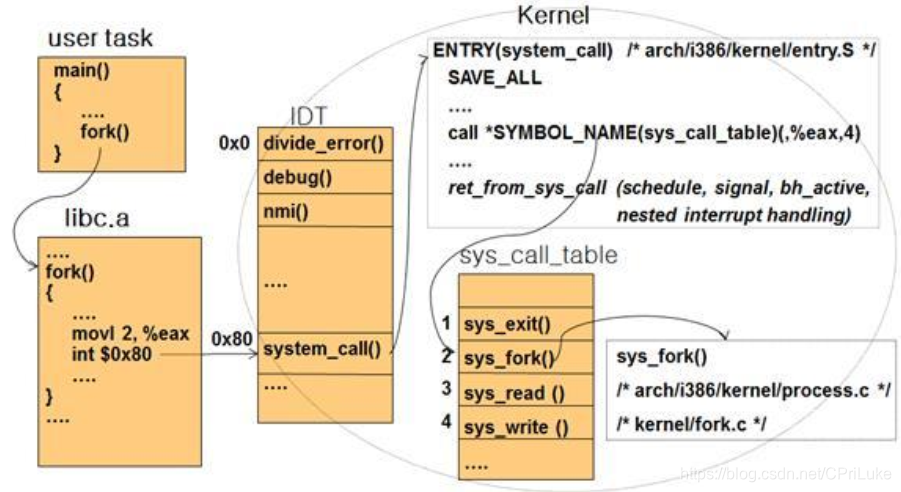文章目录
1. 概念
1.1 ABI与API
问题: 保持一个稳定的 ABI 和保持一个稳定的 API相比,谁更困难,为什么?
ABI: ABI是一系列约定的集合,可以说调用惯例(calling convention)就是ABI。因此, ABI是和具体CPU架构和OS相关
的。具体而言, ABI包含以下内容:
1. 一个特定的处理器指令集
2. 函数调用惯例
3. 系统调用方式
4. 可执行文件的格式(ELF,PE)
API: 应用程序调用接口, 比如Linux API是Linux内核与用户空间的API,也就是让用户空间的
程序能够通过这个接口访问系统资源和内核提供的服务。 LinuxAPI由两部分组成: Linux内核的系统调用接口和GNU C库(glibc
)中的例程。
因此,ABI更困难,因为API只自定义函数接口, 如POSIX 标准, 不限制不同系统对其的具体实现; 但ABI去限定底层实现框架,过于严格。
1.2 系统调用与中断,异常比较
| 机制 | 源头 | 处理机制不同 | 服务响应方式不同 |
|---|---|---|---|
| 系统调用 | 应用程序请求OS提供 | 用户发出请求后等待OS的服务 | 异步/同步 |
| 中断 | 是外设发出的请求 | 内核态下运行,对用户是透明的 | 异步的 |
| 异常 | 是应用程序意想不到的行为 | 或者杀死进程,或者重新执行引起异常的指令 | 同步的 |
1.3 调用流程

以fork()调用为例讲解
- 从用户程序中调用
fork - 在
libc库中把fork对应的系统调用号2放入寄存器eax - 通过
int 0x80陷入内核(存在优化) - 在中断描述表
IDT中查到系统调用的入口0x80(存在优化)
#define SYSCALL_VECTOR 0x80
// IDT的初始化在 \arch\i386\kernel\traps.c
void __init trap_init(void)
{
set_system_gate(SYSCALL_VECTOR,&system_call); // system_call 本质是一个汇编地址
}
- 进入Linux内核的entry_32(64).S文件,从系统调用表sys_call_table中找到sys_fork的入口地址
# system call handler stub
ENTRY(system_call)
pushl %eax # save orig_eax
SAVE_ALL
GET_THREAD_INFO(%ebp)
cmpl $(nr_syscalls), %eax
jae syscall_badsys
# system call tracing in operation
testb $_TIF_SYSCALL_TRACE,TI_FLAGS(%ebp)
jnz syscall_trace_entry
syscall_call:
call *sys_call_table(,%eax,4)
movl %eax,EAX(%esp) # store the return value
- 执行
fork.c中的do_fork代码 - 通过
iret或者sysiret返回
syscall_exit:
cli # make sure we don't miss an interrupt
# setting need_resched or sigpending
# between sampling and the iret
movl TI_FLAGS(%ebp), %ecx
testw $_TIF_ALLWORK_MASK, %cx # current->work
jne syscall_exit_work
restore_all:
// 里面有iret命令, 返回用户空间
RESTORE_ALL
1.4 调用流程优化

因为系统调用的实现从用户态切换到内核态,执行完系统调用程序后又从内核态切换回用户态,代价很大,为了加
快系统调用的速度,随后先后引入了两种机制——vsycalls和vDSO 。
这两种机制都是从机制上对系统调用速度进行的优化,但是使用软中断来进行系统调用需要进行特权级的切换这一
根本问题没有解决。为了解决这一问题, Intel x86 CPU从Pentium II之后,开始支持快速系统调用指令
sysenter/sysexit,这两条指令是Intel在32位下提出的,而AMD提出syscall/sysret, 64位统一使用这两条指令了。
2 实例-日志收集系统
功能: 系统调用被my_audit拦截后,记录到内核的buffer中(这是一个内核模块),测试用程序通过自己实现的系统调用my_sysaudit获取buffer;
思路:
- 因为需要增加系统调用获取内核中的buffer,因此需要修改内核,增加一个系统调用号;
- 在系统调用模块处需要记录到内核;
- 通过增加的系统调用获取内核中的数据;

2.1 内核编译
- 进入
vim arch/x86/entry/syscalls/syscall_64.tbl添加中断号
334 common rseq __x64_sys_rseq
335 common myaudit __x64_sys_myaudit
- 添加系统调用函数:在内核目录添加
vim arch/x86/kernel/myaudit.c
#include <linux/uaccess.h>
#include <linux/proc_fs.h>
#include <linux/init.h>
#include <linux/types.h>
#include <linux/sched.h>
#include <linux/syscalls.h>
#include <linux/kernel.h>
#include <asm/current.h>
void (*my_audit) (int,int) = 0;
int(*my_sysaudit)(u8,u8*,u16,u8) = 0;
// SYSCALL_DEFINE4 定义了系统调用在内核的入口
SYSCALL_DEFINE4(myaudit,u8,type,u8 *,us_buf,u16,us_buf_size,u8,reset)
{
if (my_audit){
printk("IN KENEL:my system call sys_myaudit() working\n");
return (*my_sysaudit)(type,us_buf,us_buf_size,reset);
} else
printk("my_audit is not exist\n");
return 1;
}
// 声明两个钩子函数等待实现
EXPORT_SYMBOL(my_audit);
EXPORT_SYMBOL(my_sysaudit);
- 修改makefile文件把myaudit.c添加到内核中进行编译
vim arch/x86/kernel/Makefile
obj-y := process_$(BITS).o signal.o
obj-y += myaudit.o # 添加的文件
- 增加函数声明:
long compat_ksys_semtimedop(int semid, struct sembuf __user *tsems,
unsigned int nsops,
const struct old_timespec32 __user *timeout);
// 添加函数声明 `vim include/linux/syscalls.h `
asmlinkage long sys_myaudit(u8, u8*, u16, u8);
extern void (*my_audit)(int, int);
#endif
- 拦截相关的系统调用
vim arch/x86/entry/common.c
// do_syscall_64函数中增加拦截标记
299 if (likely(nr < NR_syscalls)) {
300 nr = array_index_nospec(nr, NR_syscalls);
301 regs->ax = sys_call_table[nr](regs);
302
303 if (nr == 2 || nr == 3 || nr == 56 || nr == 57 || nr == 59) {
304 if (my_audit)
305 (*my_audit)(nr, regs->ax);
306 else
307 printk("my_audit is not exist");
309 }
}
- 编译内核, 装内核,修改内核引导
# 编译内核和模块
make image j2
make modules
make modules_install
make install
# 修改内核应道
update-grub2
reboot #重新系统
2.2 内核模块
- 在新的内核中安装
myaudit内核模块
#include <linux/init.h>
#include <linux/module.h>
#include <linux/slab.h>
#include <linux/sched.h>
#include <linux/uaccess.h>
#define COMM_SIZE 16
#define AUDIT_BUF_SIZE 20
MODULE_LICENSE("GPL v2");
struct syscall_buf{
u32 serial;
u64 ts_sec;
u64 ts_micro;
u32 syscall;
u32 status;
pid_t pid;
uid_t uid;
u8 comm[COMM_SIZE];
};
DECLARE_WAIT_QUEUE_HEAD(buffer_wait);
static struct syscall_buf audit_buf[AUDIT_BUF_SIZE];
static int current_pos = 0;
static u32 serial = 0;
//系统调用函数, 将数据拷贝到
void syscall_audit(int syscall,int return_status)
{
struct syscall_buf *ppb_temp;
struct timespec64 nowtime;
ktime_get_real_ts64(&nowtime);
if(current_pos < AUDIT_BUF_SIZE){
ppb_temp = &audit_buf[current_pos];
ppb_temp->serial = serial++;
ppb_temp->ts_sec = nowtime.tv_sec;
ppb_temp->ts_micro = nowtime.tv_nsec;
ppb_temp->syscall = syscall;
ppb_temp->status = return_status;
ppb_temp->pid = current->pid;
ppb_temp->uid = current->tgid;
memcpy(ppb_temp->comm, current->comm, COMM_SIZE);
if(++current_pos == AUDIT_BUF_SIZE * 6/10)
{
printk("IN MODULE_AUDIT:yes,it near full\n");
wake_up_interruptible(&buffer_wait);
}
}
}
int sys_audit(u8 type, u8 *us_buf, u16 us_buf_size, u8 reset)
{
int ret = 0;
if(!type){
if(clear_user(us_buf,us_buf_size)){
printk("Error:clear_user\n");
return 0;
}
printk("IN MODULE_systemcall:starting...\n");
ret = wait_event_interruptible(buffer_wait, current_pos >= AUDIT_BUF_SIZE *6/10);
printk("IN MODULE_systemcall:over,current_pos is %d\n", current_pos);
if(copy_to_user(us_buf, audit_buf, (current_pos)*sizeof(struct syscall_buf))){
printk("Error:copy error\n");
return 0;
}
ret = current_pos;
current_pos = 0;
}
return ret;
}
extern void(*my_audit)(int,int);
extern int (*my_sysaudit)(u8,u8*,u16,u8);
static int __init audit_init(void)
{
my_sysaudit = sys_audit;
my_audit = syscall_audit;
printk("Exiting System Call Auditing\n");
return 0;
}
module_init(audit_init);
static void __exit audit_exit(void)
{
my_audit = NULL;
my_sysaudit = NULL;
printk("Exiting System Calling Auditing\n");
return;
}
module_exit(audit_exit);
2.3 测试内核模块
- 通过如下测试程序调用我们自己实现的系统调用
sys_myaudit
#include <stdlib.h>
#include <stdio.h>
#include <errno.h>
#include <signal.h>
#include <time.h>
#include <sys/resource.h>
#include <sys/syscall.h>
#include <sys/types.h>
#define COMM_SIZE 16
typedef unsigned char u8;
typedef unsigned int u32;
typedef unsigned long long u64;
struct syscall_buf
{
u32 serial;
u64 ts_sec;
u64 ts_micro;
u32 syscall;
u32 status;
pid_t pid;
uid_t uid;
u8 comm[COMM_SIZE];
};
#define AUDIT_BUF_SIZE (20 * sizeof(struct syscall_buf))
int main(int argc, char *argv[])
{
u8 col_buf[AUDIT_BUF_SIZE];
unsigned char reset = 1;
int num = 0;
int i, j;
struct syscall_buf *p;
int max = 100;
while (max-- > 0)
{
// 调用335系统调用
num = syscall(335, 0, col_buf, AUDIT_BUF_SIZE, reset);
printf("num :%d\n", num);
p = (struct syscall_buf *)col_buf;
for (i = 0; i < num; i++)
{
printf("num[%d],serial:%d,\t syscall :%d,\t pid:%d,\t comm:%s,\t time:%s\n", i, p[i].serial, p[i].syscall, p[i].pid, p[i].comm, ctime(&p[i].ts_sec));
}
}
return 1;
}